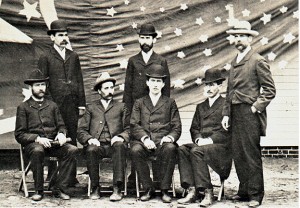Click to join the conversation with over 500,000 Pentecostal believers and scholars
Click to get our FREE MOBILE APP and stay connected
| PentecostalTheology.com



Even though not intending to form a new church or denomination, their rejection of Landmarkist values placed them in conflict with traditional churches in that area. Within a short period of time it became clear that they would not be allowed to remain as members of their churches. On August 19, 1886, after being barred from his local Baptist church, he and eight others organized the Christian Union at the Barney Creek Meeting House in Monroe County, Tennessee. They agreed to free themselves from man-made creeds and unite upon the principles of the New Testament. Between 1889 and 1895, Spurling organized three other congregations, all with the name Christian Union and functioning independently under Baptist polity.[26] While this group would later disband and its members return to their original churches,[27] the Church of God traces its origins to this 1886 meeting.[2]
In 1896, three Tennessee evangelists (William Martin, Joe M. Tipton, and Milton McNabb) with links to Benjamin H. Irwin’s Fire-Baptized Holiness Church brought the message of entire sanctification to the western North Carolina countryside when they held a revival in the Schearer Schoolhouse near Camp Creek in Cherokee County. A feature of this revival was that some participants, including children, spoke in tongues when they experienced sanctification. This phenomenon caused great excitement and controversy in the community, and leading Baptist and Methodist leaders soon denounced the revival. Several of the worshiper’s homes, as well as a provisional meeting house were burned by mobs opposing the new revival.[28]
The worshipers began to meet in the house of William F. Bryant (1863–1949), a Baptist deacon prior to his joining the holiness movement, who assumed leadership of the group. R.G. Spurling often worshiped with the small fellowship and was the driving force behind its 1902 decision to organize into a church, called the Holiness Church at Camp Creek.[29] Organization was made necessary because Irwin’s more fanatical teachings were influencing the movement, and there was a need for authority to discipline erring members.[30]
Tomlinson era (1903–1923) Edit It would be Ambrose Jessup Tomlinson and his organizational skills, however, that would be responsible for the growth of the Camp Creek Holiness Church into a national denomination. A Quaker and colporteur for the American Bible Society, Tomlinson had received the sanctification experience and had connections with Frank Sandford’s Shiloh church in Durham, Maine. While not an ordained minister, churches often invited him to preach. The church at Camp Creek had known Tomlinson for seven years before they asked him to join their church in 1903. After climbing what is now known as Prayer Mountain in Murphy, North Carolina, and reportedly being divinely assured that this fledgling church was indeed God’s reestablishment of the New Testament church, Tomlinson joined the church and was soon elected its pastor.[31] This allowed Spurling and Bryant to pursue evangelism. Fourteen new members were added to the church in the first year of Tomlinson’s pastorate, and other churches were soon established in Georgia and Tennessee.[32]
By 1905, there was a desire for greater organization among the churches. Delegates from four churches met at Camp Creek in January 1906 to conduct the 1st General Assembly of the “Churches of East Tennessee, North Georgia and Western North Carolina”. Though the intention was still to avoid the creation of a creed and denomination, the members’ consensus on certain endeavors and standards laid the groundwork for the future denomination. The Assembly declared, “We hope and trust that no person or body of people will ever use these minutes, or any part of them, as articles of faith upon which to establish a sect or denomination”, and that it was not “a legislative or executive body, judicial only”.[33] The 1st Assembly decided that foot washing was on the same level as the sacrament of communion and, like other holiness groups, condemned the use of tobacco. Tomlinson served as moderator and secretary.[34] The name “Church of God” was adopted in 1907, and Tomlinson was elected general overseer in 1909.[10]



Cole safes
WTF very funny
Varnel Watson
A good OP for the so called mavericks to educate themselves Terry Wiles
Varnel Watson
I find this ONE of the best rads this group ever produces Melvin Harter Peter Vandever Joe Absher
Joe Absher
Is that what defines though ?
Varnel Watson
what do you mean Joe Absher did you read the article ?
Joe Absher
Is tongues the defining act of pentecost . do you need work or something ?
Varnel Watson
YES Joe Absher in American Pentecostal theology tongues IS the defining act of pentecostl it comes after a very long theological process of formation From salvation by grace, via entire Sanctification and Wesleyan renewal to tongues being experienced but NOT defined and finally tongues as initial evidence. In 21c it has been going backwards tho, ppl want the gifts but not the initial evidence Instead of casting demons out as a NT ministry they have gone to OT story telling And in some cases brief intro 3 jokes and benediction without altar prayer as Peter Vandever dully noted Pentecostal POWER has been replaced by evangelical nothingness and political porn Covid and the riots are just part of it
Joe Absher
Exactly